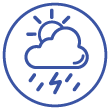Climate
-
Read more…

Climate observations
Climate is the long-term pattern of prevailing weather conditions (rainfall, temperature etc.) for a particular locality or region, while weather refers to the state of the atmosphere at or for a brief period of time.
-
Read more…

Coasts and oceans
Sea surface temperatures around Queensland (particularly in the Coral Sea, but also in the Gulf of Carpentaria) provide an indicator of the likelihood of the formation and development of tropical cyclones and east coast lows.
An Introduction to Climate in the Queensland State of the Environment Report
Management Responses
Management responses are the actions or initiatives undertaken to protect, maintain and restore environmental assets, as well as those that prevent, mitigate or adapt to changes in the environment. They are generally developed in reaction to the observed or anticipated pressures and impacts, or the state of the environment. They act in a multitude of ways, either individually or, more often, in concert with one another to bring about environmental change.
Applicable management responses related to climate include:
Legislation
-
The Coastal Protection and Management Act 1995 provides for the declaration of a Coastal Management District over coastal areas that need protection or management, especially with respect to the area’s vulnerability to erosion, to maintain or enhance coastal resources, or for planning and development management of the area.
More information:
-
Queensland’s coast is a significant natural resource and provides valuable ecosystem services that support the state’s economic and social development.
The Coastal Protection and Management Act 1995 provides for the protection, conservation, rehabilitation and management of the coastal zone, including its resources and biological diversity and works with the Planning Act 2016 to guide land use planning and development assessment decisions on Queensland’s coast.
More information:
Policy and Programs
-
Through best practice community engagement, the Queensland Government is helping Queenslanders understand and adapt to climate change. This includes regionally-specific information and tools such as the Queensland Future Climate website, the Climate Change in Queensland map application, Regional Climate Impact Summaries and climate risk toolkits.
Policies and Programs include:
- Queensland Strategy for Disaster Resilience
- Drought and Climate Adaptation Program
- State Planning Policy 2017 including guidelines to address the impacts of climate change
- Queensland Water Act 2000 including guidelines to incorporate climate change in water security risk planning.
More information:
-
The Coastal Management Plan commenced in March 2014, formed under the Coastal Protection and Management Act 1995. It provides non-regulatory policy guidance to coastal land managers.
The plan deals with key management policies such as:
- maintaining coastal landforms and physical coastal processes
- conserving nature
- maintaining access to coastal resources for indigenous cultural activities
- maintaining or enhancing public access
- management planning
- knowledge sharing and community engagement.
More information:
-
Disaster Recovery Funding Arrangements (DRFA) are jointly funded by the Australian and Queensland Governments, providing financial assistance to communities affected by natural disasters. Funding applies to eligible events that occur after 1 November 2018. The DRFA replaces the previous Natural Disaster Relief and Recovery Arrangements (NDRRA). The DRFA has more flexibility than its predecessor in the way in which the program is funded and delivered.
Under the arrangements, the relevant state or territory government determines which areas receive DRFA assistance and what assistance is available to individuals and communities based on the extent of the natural disaster. Where the DRFA is activated, the Australian Government provides up to 75% of the assistance, which is delivered through state and territory agencies. Under exceptional circumstances, Category D funding can be activated for environmental repair and recovery works. These repair works not only enhance the resilience of catchments to future extreme weather events, but also help improve water quality within freshwater and marine environments.
More information:
-
Natural Disaster Relief and Recovery Arrangements (NDRRA) are jointly funded by the Australian and Queensland Governments and apply to eligible events that occurred prior to 31 October 2018. The intent of the NDRRA to is to provide financial support for communities affected by natural disasters. Under the arrangements, the relevant state or territory government determines which areas receive NDRRA assistance and what assistance is available to individuals and communities based on the extent of the natural disaster. Where the NDRRA is activated, the Australian Government provides up to 75% of the assistance, which is delivered through state and territory agencies. Under exceptional circumstances, Category D funding can be activated for environmental repair and recovery works. These repair works not only enhance the resilience of catchments to future extreme weather events, but also help improve water quality within freshwater and marine environments.
More information:
-
The Queensland Government is investing $16 million in partnership with the Local Government Association of Queensland to help coastal communities plan and prepare for storm tide inundation, coastal erosion and rising sea levels from climate change. Open to coastal councils, the investment attracts additional funding through local council contributions and support council decision-making along the Queensland coast.
QCoast2100 enables councils to identify coastal hazards and climate change risks to their communities and to plan for adaptation. The program recognises that Queensland’s coastal councils are at different stages in their adaptation journey and provides a flexibility program, technical support and information sharing to assist councils.
More information:
-
The Queensland State Disaster Management Plan (QSDMP) is primarily intended for disaster management stakeholders within the state of Queensland. The QSDMP establishes the framework, arrangements and practices that enable current and future disaster management in Queensland. It includes guidance for disaster management stakeholders through the provision of commentary and directions to supporting documents such as plans, strategies or guidelines. The plan highlights significant elements of disaster management which are important to all Queenslanders.
The plan aims to mitigate the effects of, prepare for, respond to, recover from and build resilience to disaster events under the current and future climate.
The Queensland State Natural Hazard Risk Assessment informs the plan. As the risk assessment matures, the plan will change.
Priority Areas
- Risk Management— Understanding our disaster risk enhances resilience, preparedness, response and recovery.
- Planning—Informed by risk and developed in consultation and collaboration.
- Local Focus—Disaster management activities assist local disaster management groups, who are provided with committed and meaningful support.
- Resilience— Economic costs of disasters will rise as will their frequency. Focusing on resilience will enable us to meet this challenge.
More information:
-
The State Planning Policy recognises that mitigating and adapting to climate change is an important consideration for planning at all levels and that all State Interests should be applied and considered in the context of a changing climate.
Sea level rise from climate change is required to be considered in planning and development assessment by the State Planning Policy’s State Interest for Natural Hazards. It is included in the hazard assessments for coastal erosion and storm tide inundation. The policy mandates a sea level rise factor of 0.8m at 2100. This factor has been incorporated into statutory erosion prone area plans and indirectly in the coastal management district, which is a statutory layer used for triggering development assessment on the coast under the Planning Regulation 2017.
More information:
-
The Queensland Government supported the development of 8 Sector Adaptation Plans (SAPs) for: built environment and infrastructure; agriculture; tourism; human health and wellbeing; emergency management; biodiversity and ecosystems; small and medium business; and the energy, mining and manufacturing sectors. The Queensland Government and sector stakeholders are co-investing in projects to implement high priority actions in each SAP.
SAPs help to prioritise climate change activities across the key sectors and systems of the community. They have been developed in consultation with sector and industry stakeholders to reflect the needs and priorities of each sector. They identify emerging opportunities, share knowledge and encourage collaboration.
More information:
-
Shoreline erosion management plans, prepared by local governments with technical advice from the State, support localised, effective and sustainable responses to shoreline erosion issues within specific communities.
More information:
-
The State Earthquake Risk Assessment (SERA) and accompanying Tsunami Guide for Queensland (TGQ) are high-level reports intended to act as the foundational earthquake and tsunami risk assessments for all tiers of government, non-government organisations, not-for-profit organisations, disaster management groups, and others with legislated roles in disaster management.
They provide a comprehensive overview of current and future earthquake and tsunami risk in Queensland based on information derived from national assessments on these hazards developed by Geoscience Australia (GA). The development of the SERA and TGQ was underpinned by the QERMF, and was a collaborative effort led by Queensland Fire and Emergency Services (QFES) in partnership with GA, Queensland Department of Environment and Science (DES), and the Universities of Queensland (UQ) and Newcastle (UN).
More information:
-
The State Heatwave Risk Assessment (SHRA) is part of the suite of state risk assessments undertaken by Queensland Fire and Emergency Services (QFES), providing the foundational heatwave risk assessment for all tiers of government, non-government organisations, not-for-profit organisations, disaster management groups, and others with legislated roles in disaster management. It is the first, jurisdictionally-based risk assessment to feature long-term climate change projections using downscaled regional modelling undertaken by the Queensland Department of Environment and Science (DES).
SHRA was developed to provide all stakeholders with clear and consistent information regarding the changing nature of heatwave risk in Queensland. It was a collaborative effort between multiple stakeholders, coordinated through a working group led by QFES, Queensland Health, and DES.
SHRA found that the extreme heatwaves and bushfires across Queensland in 2018–2019 were an indication that the State is facing unprecedented challenges in understanding and responding to the impacts of natural hazards in a changing climate.
The assessment is intended to enable state agencies and disaster management groups to inform their planning against current and future heatwave risk whilst making a number of clear recommendations that, if enacted, would increase resilience to current and future heatwave risk.
More information:
-
Under the Queensland State Disaster Management Plan, Queensland Fire and Emergency Services (QFES) is responsible for the conduct of a state-level disaster risk assessment.
All Australian jurisdictions were required to produce a state level natural hazard risk assessment in June 2017 as directed by the Commonwealth Government. This was the first state-level assessment using the Queensland Emergency Risk Management Framework (QERMF). While the framework can accommodate all hazards, this initial, macro-level, assessment was limited to the natural hazards that have the most significant impact to the State of Queensland. As such, the risk assessment was conducted against the 7 most prevalent natural hazards that may impact Queensland:
- tropical cyclones
- riverine flooding
- coastal inundation (storm surge)
- severe thunderstorm events
- bushfires
- heatwaves
- earthquakes.
The future iteration of the State Natural Hazard Risk Assessment 2017, the State Disaster Risk Report 2020, has an expanded scope that will encompass the majority of disaster events identified within the Disaster Management Act 2003.
More information:
-
The Queensland Government is helping Queenslanders prepare for climate change in partnership with the Local Government Association of Queensland.
This includes supporting local government to plan for and respond to climate change by strengthening internal council decision-making processes through the Queensland Climate Resilient Councils program. The QCoast2100 program invests in development of local government coastal hazard adaptation plans to better plan and respond to coastal hazards.
More information:











